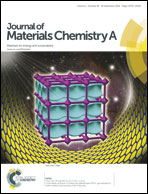The synthesis and performance of Zr-doped and W–Zr-codoped VO2 nanoparticles and derived flexible foils
Abstract
Vanadium dioxide (VO2) is a key material for thermochromic smart window applications because of its Mott phase transition properties. However, the applications of VO2 have been restricted because of its drawbacks in performance, including high phase transition temperature (Tc), low luminous transmittance (Tlum), limited solar energy modulation ability (ΔTsol) and unpleasant color. Various studies have been undertaken to resolve these problems but the improvement in any one aspect is always accompanied by a deterioration of the others. This paper reports that Zr doping can simultaneously decrease Tc, increase Tlum, improve ΔTsol and modify the color of VO2 foils. The Tc value decreased from 68.6 °C to 64.3 °C at 9.8% Zr-doping; meanwhile, the composite foils prepared from Zr-doped VO2 nanoparticles exhibited excellent luminous transmittance (up to 60.4%) and solar energy modulation ability (up to 14.1%). The experimental optical band gap was 1.59 eV for the undoped VO2, which increased to 1.89 eV at 9.8% doping. As a result, the color of the Zr-doped foils was modified to increase their luminous transmittance and lighten the yellowish color of the VO2 foil. The first-principles calculation was in good agreement with the experiment results. The W–Zr-codoped VO2 nanoparticles were prepared to further decrease the transition temperature (28.6 °C), while simultaneously maintaining the luminous transmittance (48.6%) and solar energy modulation ability (4.9%) of the derived foils.


 Please wait while we load your content...
Please wait while we load your content...